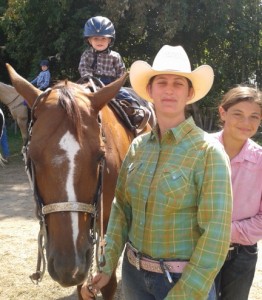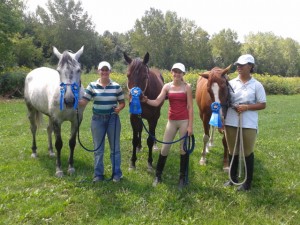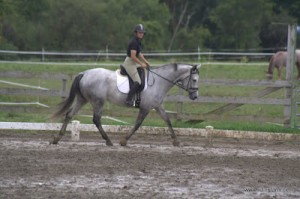By attuning herself to the tiniest details of her horse’s attitude while lunging, noticing, for example, the set of her horse’s mouth, or the carriage of his head and neck, Karlene Bulson can tell if he might rear up later on with a rider on his back.
The New York-based equestrian, and off-track Thoroughbred trainer, has spent a lot of time considering the little things when figuring out how to ensure a happy, safe ride.
“I’ve been training horses since I was 16,” Bulson says. “My first horse was a big Standardbred gelding, and I’ve had all sorts of horses and breeds. But, my favorites are the off-track Thoroughbreds and Quarter Horses.”
Bulson has ridden semiprofessionally and competed at the St. Clements Horse Show in Saratoga and at many AQHA shows as well. And not every horse is horse-show ready when she starts training!
In this week’s Clubhouse Q&A, Bulson discusses what she has learned about a horse who rears, and offers advice for changing that behavior.
Q: How do you spot a horse who might be a “rearer,” and what do you do if you see signs before you ride?
There’s a lot to watch while you’re working with them on the lunge line. Their eyes and their mouth reveal a lot.
Horses who hold a lot of tension in their chin, and display a rigid set to their chin while they’re working, are showing me that they’re really tense. I’ve noticed that tension in the mouth, and in the way that they carry their head and neck, is a sign that they could easily be the type to rear. A bucking horse, on the other hand, will hold more tension in his back.
If I see that rigidity in the mouth, I do a lot of exercises that send them away from me, and toward an object they might want to play with. Horses who rear don’t tend to be very mouthy horses, and don’t tend to want to grab stuff. So, I actually teach them to play and be a little more “mouthy,” and that has helped them relax and stop the rearing behavior.
Q: What was the most challenging ride you’ve ever had, and how did you get into a mental frame to handle the challenge?
My Quarter Horse used to present the biggest challenges with rearing, especially out on the trail. He would rear up when a big truck went by; that would just set him off.
So, to show him that the trail wasn’t scary or dangerous, I started ponying him out on the trails with another horse. As soon as he figured out that the other horse wasn’t afraid, he calmed down too.
I also had a bad day once with my stallion. He reared straight up into the air, and my only option was to slide off the back of him. I landed on my feet with the reins still in my hand!
With him, he was having a play day, and the behavior wasn’t due to other issues.
Q: What are some of the factors that trigger this kind of behavior?
There are two things I always check when there’s a rearing problem. First, I check the fit of my saddle, to make sure it isn’t pinching them, and I also have my chiropractor check their back.
With the saddle, some people inadvertently fit one that is too tight, and pinch the withers. It’s good to pay attention to how the shoulder blade is lying, and to remember that when a horse lifts his front leg, his shoulder blade comes up and back through the center of the saddle. If it doesn’t have enough clearance, it will hinder the movement and the animal will feel trapped.
When I fit a saddle, I put my hand up underneath to their shoulder, and have a friend lift the horse’s leg so I can feel if my hand gets pinched. If it does, I know the horse is getting pinched, and the saddle doesn’t fit.
I had this issue with one of my horses, who was wearing a medium-tree jumping saddle. I moved her up to a medium-wide Bevel saddle, and she loves it.
Another key to behavioral issues is back health. When a horse gets out of alignment, his lumbar vertebrae can become pinched to the point that they can’t feel their limbs. I had a horse who had this, and he walked funny because he couldn’t feel his hind end. After a chiropractic adjustment, he was 100 percent sound, and his movement issue resolved immediately.
Q: Do you have any tips for getting a horse’s front feet back on the ground, should he rear up?
The first thing I do is push my hands up and into their neck. Some people say you should hit them on the pole, but I’ve found that horses get more reactive with that.
Although it goes against the natural instinct, which is to sit back, where the center of gravity is, you should try to push your body as far forward as you can, but keep your leg position from sliding too far back. If that happens, you risk sliding off the back of the horse.
If you can, dismount and work your horse laterally from the ground.




